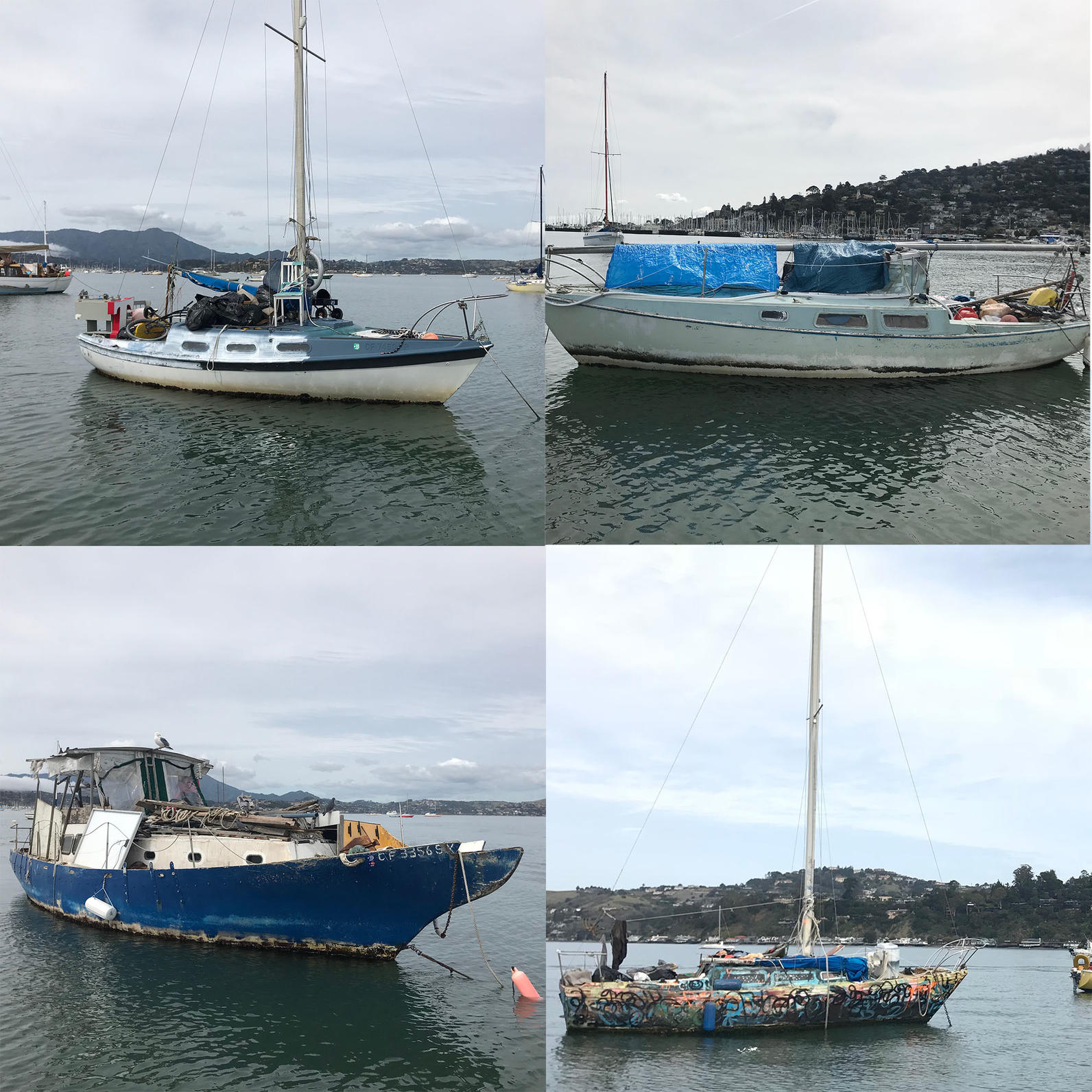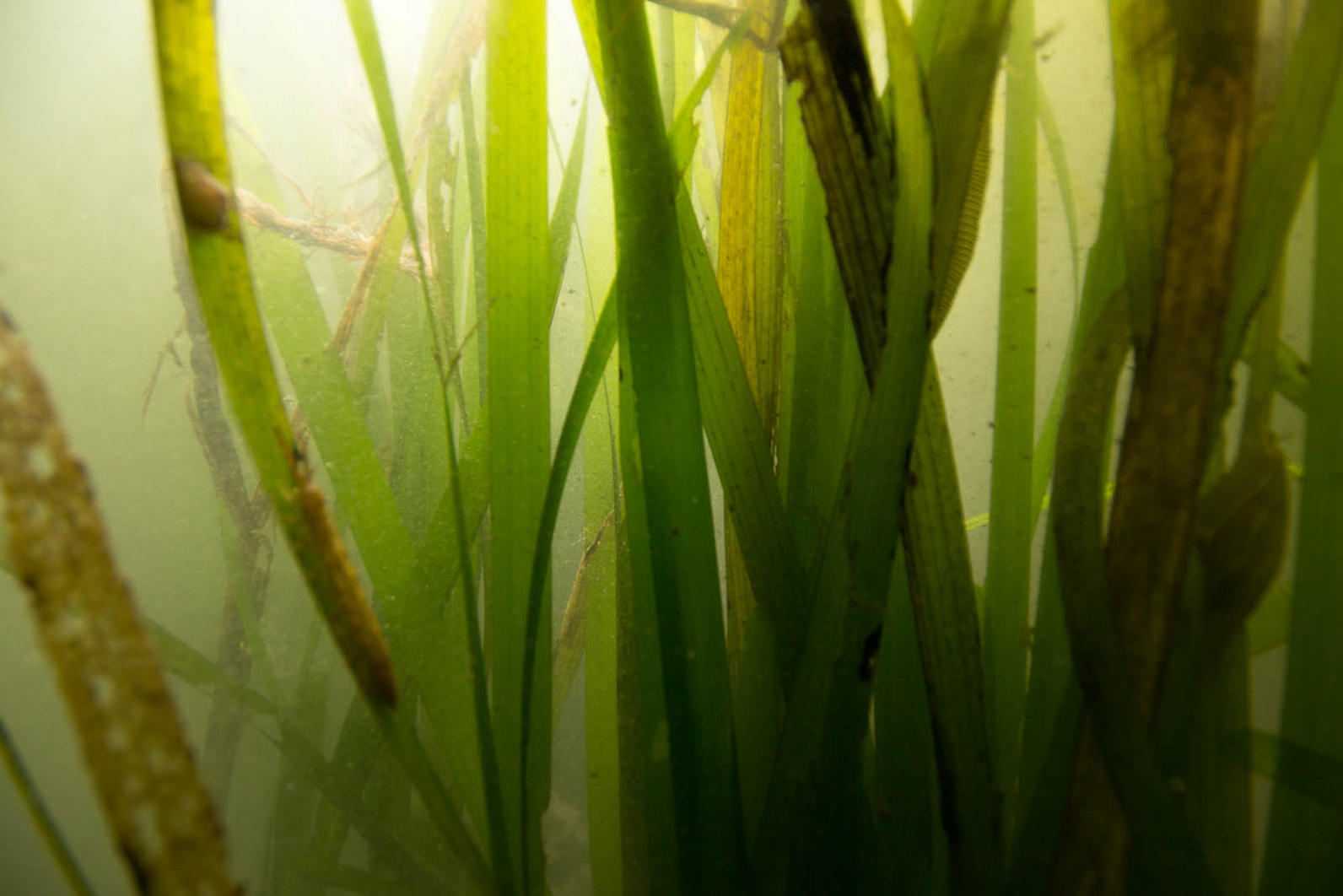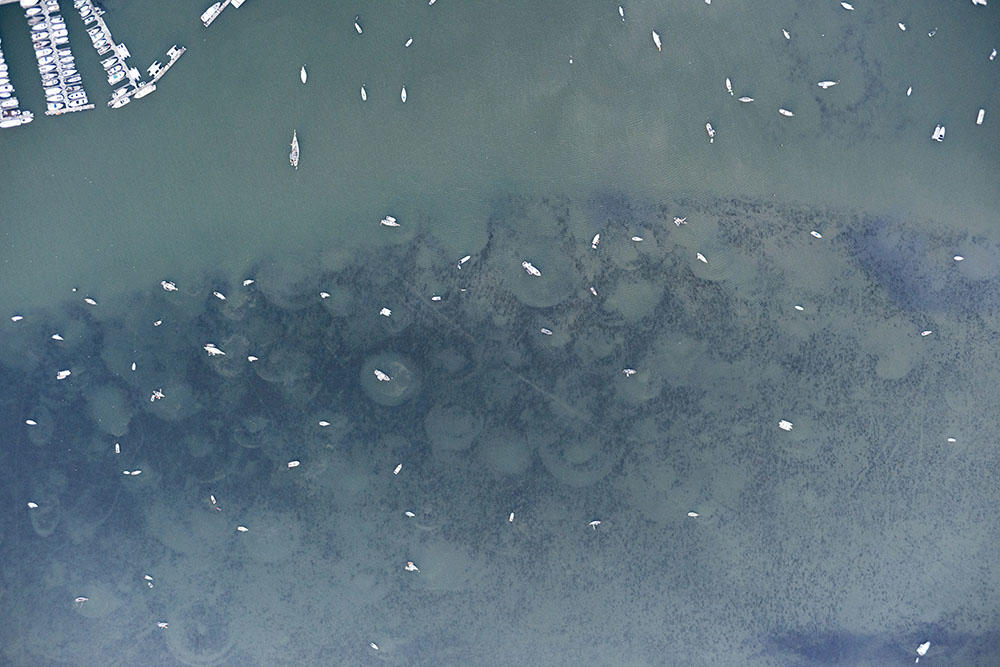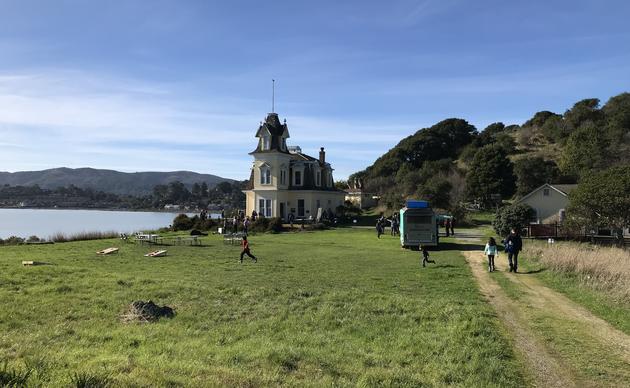
Julia Kelly pulls up the paddle and lets her kayak drift across the water, dropping her hand over the side into the water to feel what’s beneath.
“It feels like seaweed, but it’s literally a grass,” she says. “Just imagine an underwater meadow, a complete healthy ecosystem with bugs and wildlife, even birds.”
Kelly is a conservation program manager in Audubon California’s San Francisco Bay Program, and she holds a PhD in geography, with a specialization in avian ecology and conservation biology. One of her duties is protecting and studying the extensive eelgrass beds in the 900-acre Richardson Bay Audubon Sanctuary, the only subtidal sanctuary in San Francisco Bay and perhaps the California coast. These eelgrass beds extend beyond the sanctuary, however, toward Sausalito.
As Kelly puts her paddle back in the water, she looks southward toward Sausalito, and the scores of boats anchored and moored outside the marinas, in the middle of the eelgrass beds. These boats, and the damage they cause eelgrass, have increasingly been the center of controversy in this corner of San Francisco Bay – the latest example of how conservation issues are increasingly interwoven with societal issues such as housing, homelessness, and cultural identity.

The importance of eelgrass
Eelgrass is widely known to be crucial food for birds such as Black Brant, and it provides habitat for fish and crustaceans that in turn feed a wide array of waterbirds, such as Surf Scoter. For many reasons – including dredging, coastal development, climate change, and aquaculture– California’s invaluable eelgrass beds have declined throughout the state. For instance, the once booming eelgrass beds in Morro Bay are now all but gone. Half of the state’s remaining eelgrass is now found just within San Francisco Bay. This decline prompted the California Department of Fish and Wildlife to declare eelgrass a protected habitat, and highly regulate any activity that might threaten it.
San Francisco Bay’s large eelgrass beds contribute to its beauty, but they also provide nurseries for Pacific herring and support wintering waterbirds and other wildlife. Eelgrass, herring, and waterbirds are inextricably entwined in this fragile urban ecosystem. Many species of birds and other marine wildlife depend on herring as a food source, and the herring, in turn, depend on intact eelgrass beds.
San Francisco Bay’s eelgrass habitat is also on the wane. According to Merkel and Associates (the group that conducts bay-wide eelgrass assessments), over 900 acres of eelgrass was lost in San Francisco Bay between 2009 and 2014. This represents a 25% loss of total eelgrass cover, with an even higher percentage lost in Richardson Bay. This has contributed to the decline of a number of waterbird species, such as Surf Scoter whose Bay Area populations are down by as much as 90% over the past three decades. The loss of this eelgrass-herring ecosystem would put tens of thousands of wintering and migrating birds in jeopardy, impacting populations of species like Black Brant and Buffleheads up and down the Pacific Flyway migration route.
Sausalito’s anchor outs
Boats have anchored and moored in the calm protected waters of Richardson Bay off the shore of Sausalito since at least the 19th century. When the Bay’s eelgrass was healthy and the area’s urban population low, the impact of the anchoring was relatively minor. These so-called “anchor outs” thrived as part of the area’s free-wheeling, artist character of the 1960s, and have continued to this day. Now numbering more than two hundred boats, some are well-kept sailboats and powerboats, others are barely sea-worthy and piled high with belongings. Others are essentially abandoned, often breaking free from their anchors during storms and washing up along the shores of Richardson Bay.
The Marin Audubon Society and the California Department of Fish and Wildlife first brought the impact of these anchor outs to Audubon California’s attention. For years, Marin Audubon has advocated for the removal of the anchor-outs because of the pollution and damage to eelgrass habitat.
Rebecca Schwartz Lesberg, Audubon California’s San Francisco Bay program director, said the scale of the eelgrass loss off Sausalito wasn’t completely understood until her team was able to access aerial photography of the area.

“When you look at the pictures from above, you can clearly see each boat and how the ground tackle is clearing out a radius of eelgrass, causing damage from anchor scour and creating so-called ‘crop circles’ of bare ground in the eelgrass bed,” says Schwartz Lesberg. “From a conservation perspective, it’s jaw-dropping.”
Subsequent mapping of the area by Audubon California has shown that between 50 and 84 acres of eelgrass have been lost to the anchor-outs. That is nearly twice the size of Alcatraz Island. Each ‘crop circle,’ or mooring scar as they are technically known, is nearly half an acre in size. The scale of damage, and the amount of damage possible from each individual boat, is significantly more than anyone had realized
Besides directly damaging the eelgrass beds through anchor scour, these boats have a myriad of impacts on the Bay’s ecology, as well as to public health and safety. The boats reduce the available surface area on the water, squeezing out space for birds to rest and forage. They also impact to water quality when boats fail to use pump-out facilities for disposing of onboard sewage or when derelict boats leak oil and fuel into the bay. The boats can even directly threaten the local community’s safety when they break loose and run aground.
“Given that these actions are illegal and causing serious damage to the ecosystem of the bay, one might think that this problem would be easy to solve,” said Schwartz Lesberg. “But it’s not simple at all.”
Tackling the problem
Audubon California came late to the debate over the Richardson Bay anchor outs. Prompted by groups such as the Marin Audubon Society, the City of Sausalito, the County of Marin, and the local Richardson Bay Regional Agency (a joint powers authority created specifically to protect Richardson Bay’s shorelines and waterways) have all at some point in recent years attempted to address the issue. Despite this, the number of anchor outs in the vicinity has increased dramatically since 2008, when there were fewer than 100, to as many as 250 boats today.
One of the reasons for the increase has been that other communities in San Francisco – such as Vallejo and Alameda – have cracked down on the illegal moorings, driving boaters toward Sausalito and Richardson Bay.
Schwartz Lesberg and other Audubon staff have been attending public hearings at the Richardson Bay Regional Agency on the issue over the last three years, with the intention of educating policymakers about the environmental impact of the anchor outs. Increasingly, those meetings have become combative affairs, where members of the anchor out community have been joined by sympathetic members of the public to strongly advocate to leave things as they are.
“You’re really starting to see things coming to a head with the anchor outs,” says Schwartz Lesberg. “More boats are turning up. The police are worried about public safety. A critical part of the natural environment is being permanently destroyed. But on the other hand, social issues like homelessness, mental health, and even questions about community character complicate the issue.
While many anchor outs are people who have chosen to live on the Bay from a number of options, many say they have nowhere else to go. Housing costs in the Bay Area, they say, would essentially make them homeless, if it were not for their boats.
For Audubon California, the situation in Richardson Bay is yet another example where an easy solution to a conservation problem is elusive because it is intertwined with broader social issues. In Southern California, for instance, one can’t have a conversation about climate change without considering air pollution, public health, and environmental justice. In the Central Valley, discussions around water for wetland habitat have to consider drought, the agricultural economy, and community water needs.
A great number of potential solutions have been proposed in Richardson Bay, including requiring less damaging anchor lines and creating a new anchor-out area outside of eelgrass beds, but right now the only way to protect eelgrass is through active enforcement of existing laws relating to time limits and marine debris. Many of the boats in Richardson Bay are abandoned and/or derelict, and these boats have the highest likelihood of dragging anchor, leaking oil and gas into the water, and becoming a danger to navigation and public safety.
“Audubon California is a conservation organization, and what we can contribute to this conversation is good science and a willingness to listen with an open mind,” says Schwartz Lesberg. “Ultimately, the Richardson Bay Regional Agency is going to have to make some tough decisions. We’ll have done our job if those decisions are the right ones.”
By Garrison Frost
Make a gift to Richardson Bay Audubon Center & Sanctuary
Make a gift today to support our complete range of programs to protect waterbirds and the environment we share.




